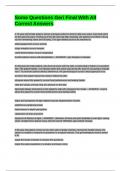Exam (elaborations)
Some Questions Geri Final With All Correct Answers
- Course
- Institution
Some Questions Geri Final With All Correct AnswersSome Questions Geri Final With All Correct AnswersSome Questions Geri Final With All Correct AnswersSome Questions Geri Final With All Correct Answers A 75-year-old female patient, whose marriage ended in divorce after two years, has lived alone fo...
[Show more]



